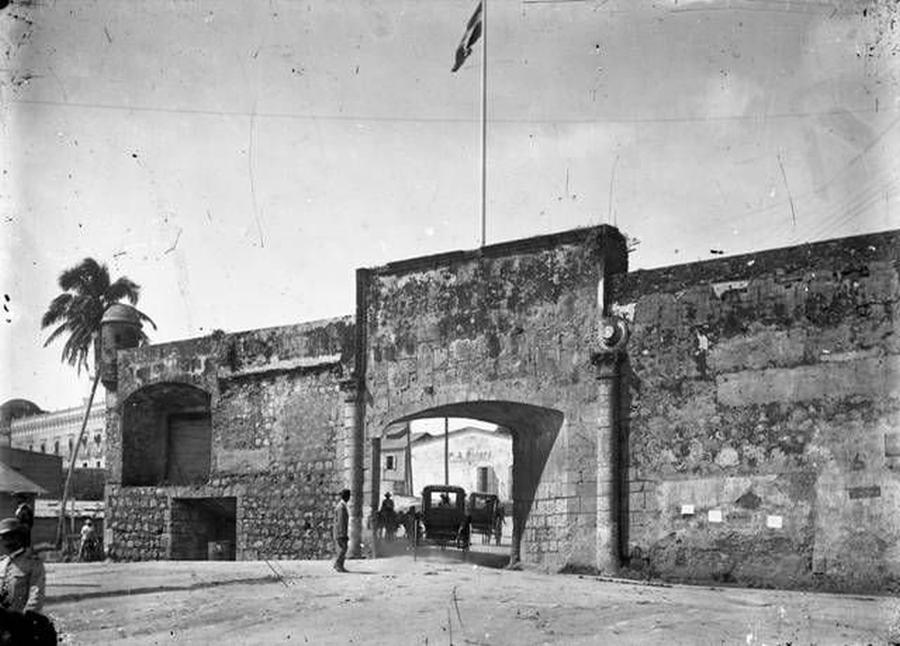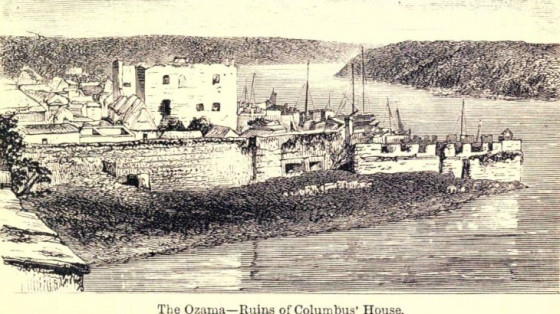Fuerte Invincible and Fuerte San Diego, The Forts on Avenida del Puerto
Two of the many important forts along Rio Ozama were Fuerte Invincible and Fuerte San Diego. They were part of a chain of forts, with cannons at the ready, that defended the colonial city of Santo Domingo and its bustling port from enemy invasions.
All of these forts and walls were raised throughout the XVI century. It is interesting to note that these forts along the riverfront were not planned as one continuous fort. They were built as the need arose and money became available.
Fuerte Invincible | Fuerte San Diego | Puerta de San Diego | Bateria del Almirante | Puerta Atarazana | Lagoon El Tanque | Location

Fuerte Invincible
Fuerte Invincible is the first fort after Fortaleza Ozama. The fortress is also called San Alberto and Coca (San Alberto y De Coca). This fort was built on the cliffs behind the mansions of Nicolás de Ovando and the Dávila family. Not only was this fort was built for the added defense of the city of Santo Domingo but more importantly to protect the mansions of the richest inhabitants of the city.
In colonial times it is important to remember that there were no banks to hold cash and treasures. Each rich family had to protect their riches on their own. When pillagers and pirates attacked these cities they went directly for the houses of the rich and the churches were important wealth and artifacts were stored. This was the purpose of the high walled Fuerte Invincible.

This foreboding sturdy fort had openings for 12 cannons on both its lower and higher shooting platforms. Looking up at the tall walls one could only imagine how strong this fort really was.

Fuerte San Diego
Fuerte San Diego was the 3rd fort entering Rio Ozama. This curved fort was also a busy port of entry for the Colonial City of Santo Domingo. It was a very important part of protecting the walled city from attack from marauders entering the Rio Ozama from the Caribbean Sea.

The main part of the fort was destroyed in 1886 to extend the ports. The beautiful fort was reconstructed when the work on the Malecon was finished. The original base of Fort San Diego was discovered during archaeological excavations.

All that stands now is a small part of the fort in the center of la Avenida del Puerto, a few remnants of the walls of the fort and the rebuilt Puerta San Diego.

Puerta de San Diego
In front of the beautiful Puerta de San Diego / Door of San Diego (dated 1549), also called Puerta de la Mar.

The large stone pillared entrance Puerta de San Diego was completely restored in 1978. Above the door are 3 shields known as escudos. The Shield of the King / El Escudo del Rey, Shield of Hispaniola / Escudo de la Isla La Española and the Shield of Santo Domingo / el Escudo de la Ciudad de Santo Domingo.

As you enter the large stone door you may want to walk on the catwalks over the door and check out the view. Turn right when entering the Puerta San Diego and you will see the stairs leading up to the look-out catwalks. This path over the gate will end in front of the Casa Reales and the Plaza of the Reloj de Sol / Sun Dial in the Plaza Reloj de Sol.

Bateria del Almirante
After the fort of San Diego, continuing along the wall, are the Bateria del Almirante. These batteries were built into and around the walled part of the house of the Admiral or Alcázar de Colón, located strategically on a hill.

Puerta Atarazana
The Puerta Atarazana was another important entrance to the city from the ports. This large doorway entered into the main shipyard of the city. The Alcazar Colon is where Admiral Columbus lived. From here he could keep an eye on all the goods and supplies as they entered and departed from the city. The catwalk above this gate gives another good view of the Rio Ozama and surrounding areas. It is interesting to note that all the buildings in this area were storage for all the goods that came into the port. Now, these buildings are nice restaurants, bars, museums and colonial homes.

This wall of defense connected Fuerte San Diego to the other forts along the Rio Ozama Fuerte Carina and Fuerte Angulo.

Lagoon Tanque
It is interesting to note that at the base of Fuerte Invincible and Fuerte Don Diego was a large lagoon that was fed by the waters of Rio Ozama. The lagoon was known as Laguna El Tanque / Lagoon The Tank. Some say it played an important part in the defensive belt for the Colonial City. After the Fuerte Ozama with its high walls lined with cannons was the narrow entrance to Rio Ozama and the tall cannon lined wall and firing platforms of Fort El Invincible with the lagoon at its base.

El Tanque ended up being a stagnant pool of polluted water. It was surrounded by a Boardwalk named El malecón del Ozama. Even though the city inhabitants protested, the nasty contaminated water from the city drained into this “The Tank”. Finally, because of the bad smells coming from the contaminated stagnant water, it was cleaned around 1912 and later filled in.
Location
A good starting point is at the Escaleras Calle el Conde / Stairs of Calle el Conde. The beautiful stairs, cut between the old walls of Fuerte Invincible, lead down to the outer walls of the city along Ave. Francisco Alberto Caamaño Deño, also known as the Malecon or Avenida El Puerta. Looking up you can see just how strong these walls were and how they did protect the homes of the wealthy.

Continue walking along the wall and you will come to a wooden bridge path, this is the beginning of Fuerte San Diego. The path ends at the Puerta San Diego. This door is beautiful with its shield and stone path. The door enters to Plaza España and the Alcazar Colón. If you continue walking on the outside of the wall it will lead to The Bateria del Almirante and the other entrance from the port Puerto Atarazana / Door of the Shipyards. The wall continues past the small police station to Fuerte Carina and Fuerte Angulo and around to Fuerte Santa Barbara.
Reference:
*https://www.diariolibre.com/noticias/ciudad/los-fuertes-en-la-avenida-del-puerto-EE3457969
*https://www.facebook.com/historiadominicanaengraficas/posts/historia-de-la-puerta-de-san-diego-en-la-zona-colonialla-puerta-de-san-diego-loc/527995694065585/
*Imágenes de Nuestra Historia, R.D
